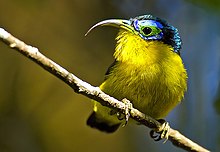Asity
| Asities | |
|---|---|

| |
| Yellow-bellied sunbird-asity | |
| Scientific classification | |
| Domain: | Eukaryota |
| Kingdom: | Animalia |
| Phylum: | Chordata |
| Class: | Aves |
| Order: | Passeriformes |
| Superfamily: | Eurylaimoidea
|
| Family: | Philepittidae Sharpe, 1870 |
| Genera | |
The asities are a family of birds, Philepittidae, that are endemic to Madagascar. The asities consist of four species in two genera. The Neodrepanis species are known as sunbird-asities and were formerly known as false sunbirds.[1]
Philepitta is now the type-genus of a new bird family, the Philepittidae, into which the asities of Madagascar have been placed.[2]
Description
Asities are small forest birds with sexually dichromic plumage and brightly coloured wattles around the eyes of the males. These wattles, which are most conspicuous during the breeding season, get their colour from arrays of collagen fibres.[3] This method of pigmentation is unique in the animal kingdom. Several other features separate them from the broadbills, they possess twelve tail feathers on extremely short (almost non-existent in the Philepitta species) tails, their syrinx is encased with a large bronchial ring and they have forked tongues adapted to nectivory.[4] They have a long outer primary which buzzes in flight, possibly used in signalling during courtship. The two genera are quite distinct.
Behavior and ecology
Diet and feeding
The major component of the diet of asities is fruit. A wide range of different fruit is taken by the family, and they are among the most important avian dispersers of seeds, as there are very few other frugivorous birds in the forests of Madagascar. They will also take insects. The Neodrepanis sunbird-asities will take nectar, but do so with a long tongue rather than inserting their curved bills far into flowers.
Breeding
Rainforest asities breed during the Malagasy
Status and conservation
One species, the
Taxonomy and systematics
They were thought to have been related to the
Species
| Image | Genus | Living Species |
|---|---|---|
 |
Philepitta |
|
 |
Neodrepanis |
|
References
- ISBN 84-87334-50-4
- ISBN 978-84-941892-0-3.
- PMID 29865414.
- ^ ISBN 84-87334-50-4
- ^ BirdLife International (2007) ["BirdLife | Partnership for nature and people". Archived from the original on 2007-07-10. Retrieved 2012-11-15./datazone/species/index.html?action=SpcHTMDetails.asp&sid=4042&m=0 Species factsheet: Neodrepanis hypoxantha]. Downloaded from "BirdLife | Partnership for nature and people". Archived from the original on 2007-07-10. Retrieved 2012-11-15. on 16/6/2007
- ^ BirdLife International (2007) ["BirdLife | Partnership for nature and people". Archived from the original on 2007-07-10. Retrieved 2012-11-15./datazone/species/index.html?action=SpcHTMDetails.asp&sid=4040&m=0 Species factsheet: Philepitta schlegeli]. Downloaded from "BirdLife | Partnership for nature and people". Archived from the original on 2007-07-10. Retrieved 2012-11-15. on 16/6/2007
- JSTOR 4088558.
External links
 Data related to Asity at Wikispecies
Data related to Asity at Wikispecies- Asities videos on the Internet Bird Collection
- Don Roberson's Bird Families of the World Archived 2008-07-24 at the Wayback Machine
